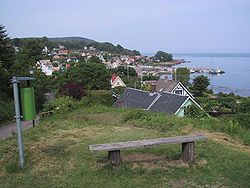Sigurd Wallin
To find motifs for his oil paintings, Sigurd Wallin made annual summer trips, most often to Scania, especially to the neighbourhood of Arild, Mölle and Båstad.
Båstad is the largest urban village in the area of Bjärehalvön (Bjäre peninsula) and it is located at Hallandsåsen with lively summer tourists who put their stamp on the place.
Båstad has the largest outdoor facilities for tennis in the Nordic countries,[citation needed] and is also known for its beaches; the resort was once known as a spa and there are still several guesthouses.
[citation needed] He graduated from Sigtunaskolan a Swedish boarding school located in Sigtuna, Sweden,[1] in the spring of 1935.
The preparation was done by students in art history and in archaeology and also by workers under the led by Otto Frödin (1881-1953), or some other experienced archaeologist.
[3][4] However Wallins interest in art, which he had received in his parents’ home, led him to begin to draw and to paint portraits.
[citation needed] Edvin Ollers (1888-1959) was a designer, an artist and a qualified art teacher and had studied at the Konstindustriskolan in Stockholm.
[citation needed] Otte Sköld, who was a Swedish artist, draftsman and printmaker, had a central place in Stockholm’s cultural life during the 1940s and 1950s.
He made several trips abroad for art studies, he visited Italy, France, the Netherlands, Germany, Switzerland, Denmark and Norway.
[citation needed] Sigurd Wallin painted in oil, landscapes, cityscapes, figurative compositions and occasionally still life.
His paintings have a romantic appropriation and preferably a slightly veiled coloring, which tied in with his father’s view of an artist.
Above all Sigurd Wallin worked in portrait painting, where he with technical skill realized the traditional demands for the genre for likeness.

